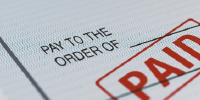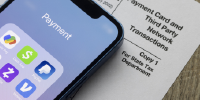Fraud Prevention Hub
Affinity is committed to protecting our members and their financial information. Our fraud prevention team has crafted these tips and advice to help you identify and avoid the latest fraud and scams.
Suspect you're a victim of fraud or identity theft?
Contact our Member Support Specialists immediately, so we can take preventative measures to protect your account:
We will never call, email, or text you asking for a one-time passcode, your account password, your card number or any other sensitive information. If you’re suspicious of a call or message, don’t respond. Contact us directly to verify authenticity and for assistance.
Fundamentals to Protect Yourself
Think Before You Click
Scammers use emails, text messages and app notifications to send malicious phishing URLs.
Your mobile device may be peppered with emails, text messages or app notifications, often containing links. These might seem harmless but could be traps laid by cyber crooks. Before clicking, ask yourself, “Do I know the sender?” If the answer is no, think twice.
If the answer is yes but something still seems off, it’s better to be safe than sorry. Double-check with the sender through a different method of communication, like a phone call or text, to confirm the link is legit.
Hang Up and Call Back
Scammers impersonate banks and credit unions to access your checking and savings accounts.
Scammers are increasingly impersonating credit union and bank representatives by spoofing (using a false caller ID number or description) legitimate phone numbers. They often create a false sense of urgency by claiming suspicious activity has occurred and they need your information to secure your account. They will then use this information to access your accounts or even steal your identity.
If you receive a call pressuring you for sensitive information, hang up, and call back the official number. Our Member Solution Hub can be reached at 800-325-0808 to assist.
Stay Safe Online
Cybercriminals will use phishing websites to look legitimate in order to steal log-in credentials.
Use only trusted websites for online transactions. Do not provide credit card numbers or personal information on any website if you are not sure the site is authentic. Choose companies with secure transactions and strong privacy and security policies.
Many scammers use social media to commit fraud. Common scams include investment scams, impersonation scams, giveaway scams, and fake online stores. While there are many legitimate items being sold on social media, some are also scams. Caution should be used before purchasing items found through social media. Researching through web searches and reading reviews about the product and/or website can save you from becoming a victim.
Practice Good Digital Hygiene
Keep Your Passwords Secure
Create strong passwords with unique characters.
Change your passwords on a regular basis.
Don't use passwords on devices you don't own.
Don't use the same password everywhere.
Consider using a secure password keeper app.
Be cautious when using free, public Wi-Fi.
Stay Aware, Stay Safe
Most people don’t realize they’ve become a victim of a scam or identity theft until it’s too late, but typically the sooner you catch it, the easier it is to the resolve. Frequent monitoring of your accounts and credit can alert you to an issue early on, and utilizing other proactive, preventative measures can also keep you safe.
Proactive Measures to Stay Safe:
- Setup dual authentication methods for important accounts. Using text message and email are good second sources, but a dedicated authenticator app is usually best.
- Create balance and transaction alerts on your accounts and review the history at least once a month.
- Consider credit monitoring, setting a fraud alert, or even a credit freeze. These all add varying levels of protection against identity theft.
- Check your credit reports. Under the FACT Act, U.S. consumers are entitled to one free credit report each year from each of the three major credit bureaus.
- Be cautious with your information. If you feel uncertain about providing sensitive information, it’s best to take extra precaution and verify the authenticity of the request. This is especially true when it comes to information like your social security or account numbers.
- Take action immediately when bills do not arrive as expected, you receive unexpected credit cards or account statements, you are unexpectedly denied credit, or you receive calls or letters about purchases you didn't make.
- Request a PIN number for your tax return, and file early.
As always, if you suspect you're a victim of fraud or identity theft, contact our Member Solution Hub immediately for support at 800-325-0808 so we can take preventative measures to protect your account.
Learn More About Protecting Against Fraud

Resolving ID Theft and Fraud
Falling victim to fraud is never something to be embarrassed about and is best resolved quickly. Here are some tips to expedite the reporting process.

Email Fraud
This is a type of fraud that happens to people both in their personal lives and at work – and is also one of the simplest and most common types of fraud.

Social Media Scams
The internet and social media have greatly expanded access to information, connectedness, and with that an increased possibility of getting scammed.

Counterfeit Check Fraud
Members are often sent counterfeit checks under various pretenses and asked to wire the sender money from the proceeds of the check.

Phone Scam Fraud
Phone scams can come in many forms, but they all have a few things in common: scammers pose as a legitimate business or government agency and create a sense of urgency.

Text and SMS Fraud
Smishing is the text message version of phishing, with scammers sending text messages posing as reputable companies to request personal information.

IRS and Utility Scams
You owe money to the IRS and there’s a risk of being arrested?! Your power is about to be shut off for an overdue balance?! Both scenarios create panic and are also scams.

Card Cracking Fraud
This scam is when a person is approached by someone asking for their credit or debit card number, with the promise of being able to keep some of the money if they will cash a check for them.

Phishing Scams
Phishing is a type of email fraud when you receive an email impersonating a legitimate company with the goal of tricking you.

Digital Payments Fraud
Digital payment services link to the user's bank account and allows them to send money to other people instantly using an email address or phone number.

Romance Scams
You meet someone online, talk often, fall in love, can’t meet in person, and then they start asking for money. These are known as romance scams.

